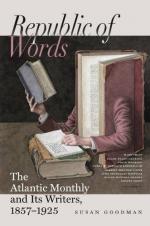FOOTNOTES:
[25] The following is the epigram of Matthias Corvinus:—
“Bella gerant alii;
tu felix nube!
Nam quae Mars aliis dat tibi
regna Venus.”
Which Mr. Sterling thus renders:—
“Fight those who will;
let well-starred Austria wed,
And conquer kingdoms in the
marriage-bed.”
Some other hand has given the following translation, or rather amplification, of the epigram:—
“Glad Austria wins by
Hymen’s silken chain
What other states in doubtful
battles gain,
And while fierce Mars enriches
meaner lands,
Receives possessions from
fair Venus’ hands.”
There would seem to be an end of these fortunate marriages, no member of the Austrian imperial family being now in condition to wed to much profit. The Emperor Francis Joseph, who is yet a young man, took to wife a Bavarian lady, said to be of extraordinary beauty, in 1854; and he has a daughter, who was born in 1856, the same year with the French Prince Imperial, whom she might marry, but that the two are children. Besides, marriages between French princes and Austrian princesses have turned out so badly on two memorable occasions, within less than a century, that even the statesmen of Vienna and Paris might well be excused if they were to think a third alliance quite impossible. The heir apparent to the Austrian throne is but eight years old. The Emperor’s next brother, Ferdinand Maximilian,—well known in this country as Emperor of the Mexicans,—made a good marriage, his wife being a daughter of the late Leopold I., King of the Belgians. She has labored with zeal to found an imperial dynasty in Mexico, but the task is beyond human strength. The imperial system fell in Mexico on the same day that Richmond fell into the hands of General Grant. The fortunes of the Austrian prince and those of Mr. Davis were bound up together, and together they fell.
[26] We give the imperial anagram:—
A: Austria Alles
E: Est Erdreich
I: Imperare Ist
O: Orbi Oesterreich
U: Universo Unterthan.
[27] Mr. Bryce credits Maximilian I. with the founding of the Austrian monarchy. “Of that monarchy,” he observes, “and of the power of the house of Hapsburg, Maximilian was, even more than Rudolph his ancestor, the founder. Uniting in his person those wide domains through Germany which, had been dispersed among the collateral branches of his house, and claiming by his marriage with Mary of Burgundy most of the territories of Charles the Bold, he was a prince greater than any who had sat on the Teutonic throne since the death of Frederick II. But it was as Archduke of Austria, Count of Tyrol, Duke of Styria and Carinthia, feudal superior of lands in Swabia, Alsace, and Switzerland, that he was great, not as Roman Emperor. For just as from him the Austrian monarchy begins, so with him the Holy Empire in its old meaning ends.” (The Holy Roman Empire, pp. 343, 344.) Mr. Bryce’s work is one of the most valuable contributions to historical literature that have appeared in this century, and great expectations are entertained from the future labors of one so liberally endowed with the historic faculty.




